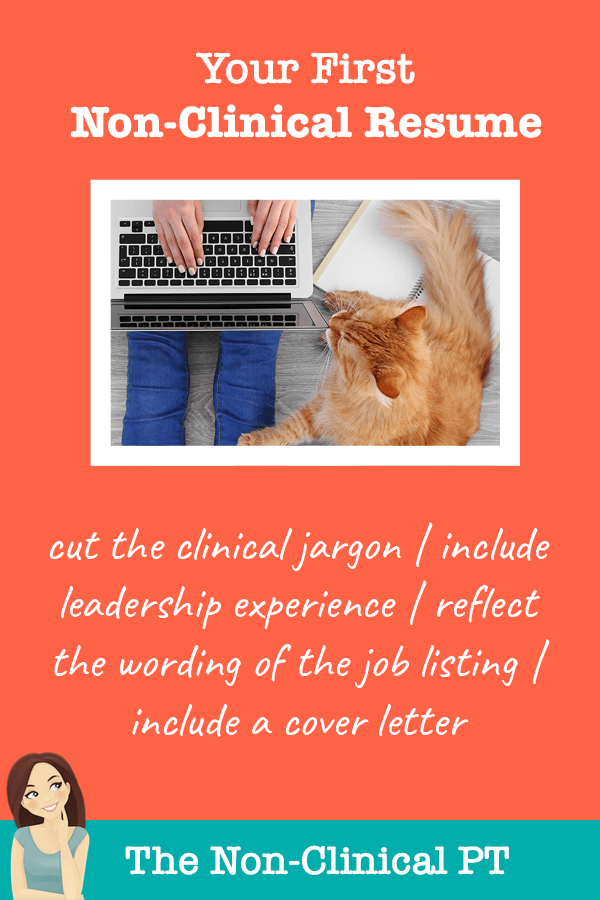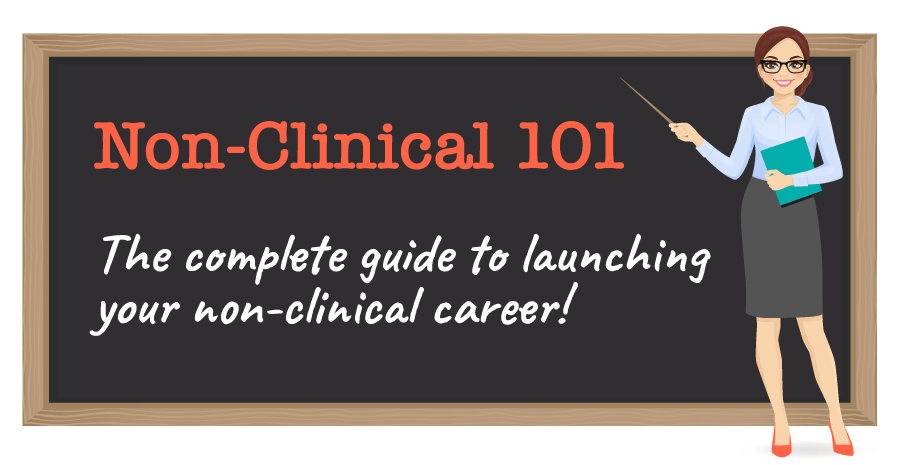Creating a non-clinical resume can feel overwhelming, but it doesn’t have to be overwhelming. This article is designed to help you see the big picture. Read on to learn how to tailor any resume—with any clinical background (PT/A, OT/A, or SLP/A)—to any job you want.
Let’s take a big step back and start with the goal of any resume.
The goal of a resume is to land an interview.
In order to land an interview, you need to show that you have the right background and capabilities to complete the job. Your resume needs to speak specifically to the job you’re pursuing.

The first thing you need to do is step back and look at your standard clinical resume. Realistically, it probably looks pretty impressive for clinical roles. It probably lists the clinical skills you have, the patient populations you’ve treated, and the CEU courses you’ve taken.
But think of that resume from the perspective of a hiring manager for, say, a sales role. Would a sales manager at a wound care-focused medical device company really care that you have completed seven different courses on gait analysis for elite runners?
Nope. But that same sales manager would probably love to see a few courses and specific work experience surrounding wound care. And that same manager would REALLY love to see formal coursework, upskilling, or experience around the actual process of selling.
Your resume must convince the hiring manager you can do the job you want, not the job you have.
Therefore, each resume you create will be tailored to a specific role by putting yourself into the hiring manager’s head and determining what you should highlight and what you should eliminate altogether.
This post may contain affiliate links or codes. This won’t increase your cost, but it helps keep TNCPT alive, and free of annoying ads! Thank you for your support. 🙂
An Example of Creating a Tailored Non-Clinical Resume
Let’s walk through an example of making a clinical resume into a non-clinical one. We’ll use the example of rehab liaison. If you’re unfamiliar with this type of work, here’s an article about rehab liaison careers.
Step 1: Examine the job you want.
Chances are, a rehab liaison job description will list responsibilities like:
- Recognize barriers to admission, respond appropriately and follow up on admissions variables.
- Represent our company in community-related activities.
- Assist with coordination of the referral-to-admission process.
- Use territory market analysis data to identify potential new business opportunities.
- Develop census as defined by targeted goals of the business plan.
- Build referral relationships within an assigned geographic territory, emphasizing face-to-face contact.
- Provide in-services and professional presentations for referral sources, community groups and others regarding our services, programs, and outcomes.
You will need to show that you are capable of doing all of the above. And you’ll also want to echo the language in the job posting itself.
Make note of the use of phrases like “assist with coordination” or “build referral relationships.” You might very well have done these things already, but you might not have them in your resume. Be sure to echo the language of the job posting.
Step 2: Replace clinical jargon with job-specific wording.
Your resume needs to be free from confusing language that might turn off a hiring manager. It can be incredibly painful to cut information from your resume. You worked hard to complete those seven “Gait Training for Runners” courses! But they aren’t relevant to rehab liaison work like a CEU course on care transitions would be.
Get rid of unrelated information and fill that resume real estate with content that relates to the role you want.
- That advanced spinal mobilization course you took?
It’s not relevant to a rehab liaison role, and it’s stealing space from something more important you should highlight on your resume. Delete. - The women’s health patient population you served? The diastasis recti con-ed course you took?
Impressive, but not relevant to a rehab liaison job. Delete.
The point here is that we’re cutting the words that will only distract a hiring manager from the qualities he or she is seeking. The good news is that you’re going to get to play up lots of cool things you’ve done that you never really thought mattered.
- Consistently meet productivity?
Don’t get me started on productivity (grrr), but that’s great that you can meet quotas. Keep it! - Always wound up giving the new PTs a tour of the hospital?
Perfect! You have experience with on-boarding new talent and building relationships. This is a valuable skill for a liaison role. - Got a knack for blogging?
This is fantastic, and shows that you’re a clear communicator. Make sure to list your blogging experience! - Managed therapists’ schedules when your supervisor was out?
Awesome; this shows that you have great time-management skills. - Belong to Toastmasters (or another networking group)?
Excellent. Your job is all about networking as a rehab liaison, so keep this on your resume! Bonus points for holding leadership roles. - Took a really cool non-clinical CEU or course where you learned skills that apply to this role?
Perfect. It belongs on your resume! - Served as captain of your kickball team?
That shows you have leadership skills. Add it to your resume.
Remember, keep anything relevant, but be sure to word it using terminology from the job posting.
In Non-Clinical 101, you’ll learn how to use Artificial Intelligence (AI) and free online tools to analyze job listings and create stellar resumes!
Step 3: Create a catchy summary.
At the top of every resume is a summary. Don’t use an objective; it dates you. This summary is the very first thing a recruiter or hiring manager will see about you. Have it summarize what you bring to the table while including some keywords from the original job posting.
Here’s an example of a summary:
“Enthusiastic, flexible, goal-oriented, and outgoing physical therapist with stellar communication skills. Six years of clinical experience in an inpatient rehab setting, with leadership, relationship-building, marketing, and interdisciplinary communication skills. Eager to join [Company Name] as a rehab liaison, in order to bring inpatient rehab services to appropriate candidates to create ideal healthcare outcomes.
This says it all! You have the experience they want, you’ve got a great personality, and you have a passion for marketing. You also indicate that you are mindful of outcomes measurements and are goal-oriented, which helps with the quota-focused side of the role!
Step 4: Quantify whenever possible…and add a tiny dash of personality.
Quantifying your achievements is crucial in the non-clinical world. It’s not enough to say you saved the team time by implementing EMR templates. You’ll want to say something like:
Implemented templates into the Epic EMR, teaching 16 therapists tech-based efficiency methods and resulting in 13% increased overall therapist productivity.
While your resume’s goal is to land you an interview—and most of that is down to quantifying achievements, listing the right skills, and using the right keywords—it also can’t hurt to provide a tidbit to add some personality.
If you have room, you can do something like include volunteer work (animals are always a great way to warm most interviewer’s hearts) or even include a reference to personality test results! Doing so creates an instant conversation piece, or even a bit of shared connection.
A little flair is great, but keep in mind that too much pizazz can be overboard. Be sure to avoid:
- Fancy fonts (stick to the basic ones, like Calibri, Garamond, or Arial).
- Fancy formatting or images (they can trip up resume-scanning software.) Keep the layout basic.
- A picture of yourself. I’m sure you’re super sexy, but some employers immediately trash resumes with pictures so they’re not accused of agism, gender/race preference, etc.
Step 5. Keep the length reasonable.
Depending on how much you’ve put on your resume, and how long you’ve been working, your resume can start to get really loooooooong. Too long.
Two pages is typically plenty to highlight the skills that are most applicable to the role.
Remember, be ruthless in slashing your clinical skills unless they directly relate to the role. And don’t be afraid to highlight experiences that aren’t from your clinical days, but are still relevant to the role you want.
Additional tips for going non-clinical.
- Do NOT skip a cover letter. Your cover letter is your chance to explain all the questions a recruiter or hiring manager might have about your resume. It’s your resume’s job to answer what you have done in the past that makes you qualified for the role. You’re flexible. You’re good with people. You have excellent communication skills. The cover letter’s job is to share why you’re making this move, and why the hiring team should take a chance on you.
- Do NOT underestimate the power of networking. Networking is very possible online these days! Check out my free networking Facebook group!
- Make a plan. Like anything else in life, you’ll have greater success if you KNOW what you want to do, and then take actionable steps to get there. If you’re not sure where to start, check out Non-Clinical 101: The Complete Guide to Launching Your Non-Clinical Career!





